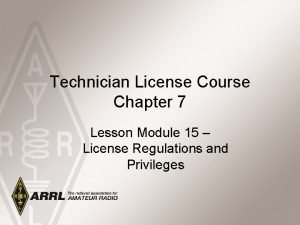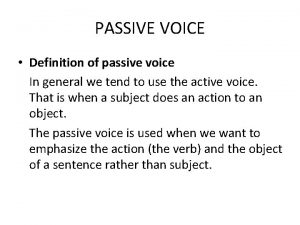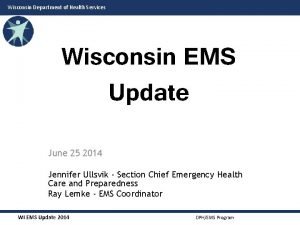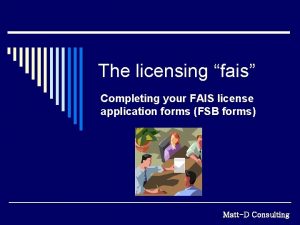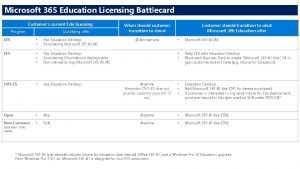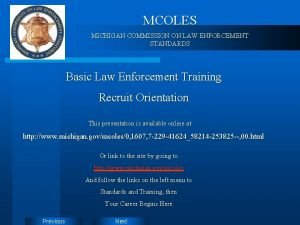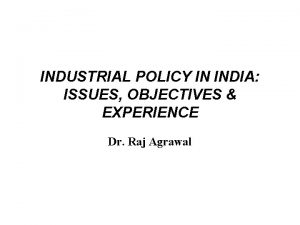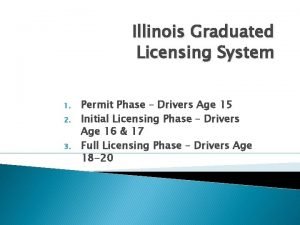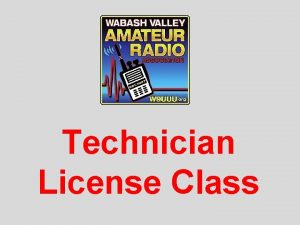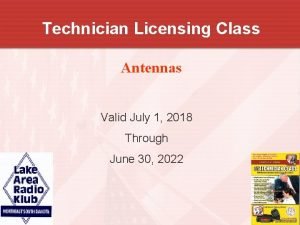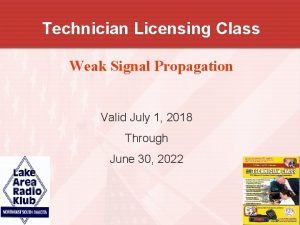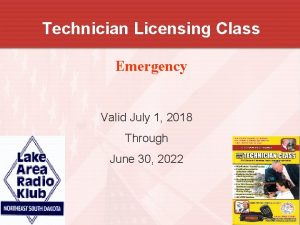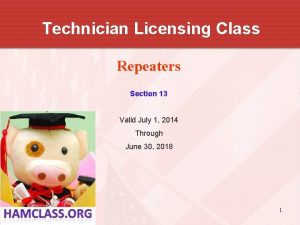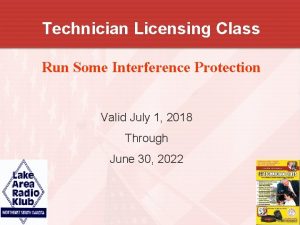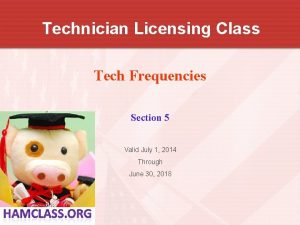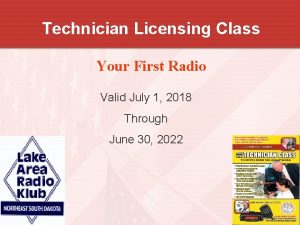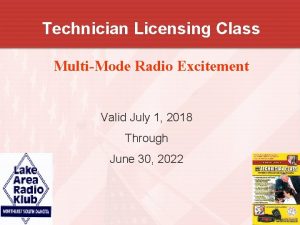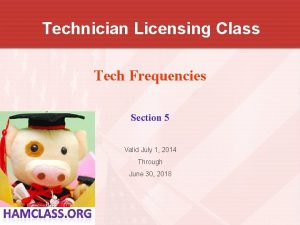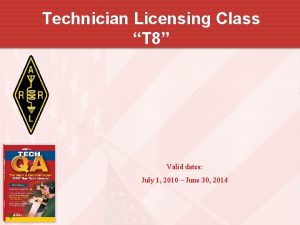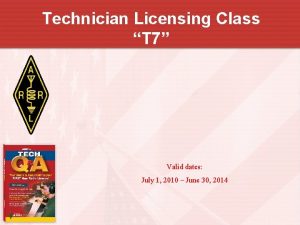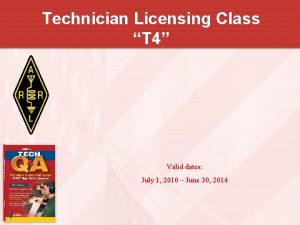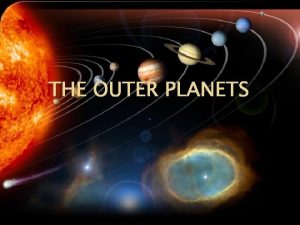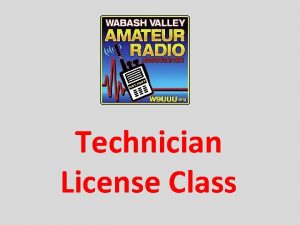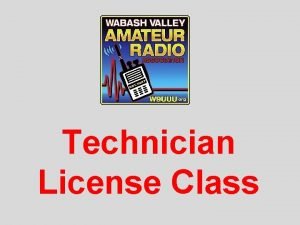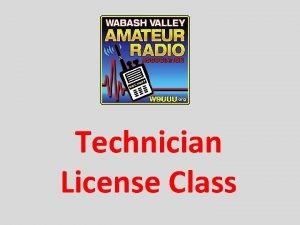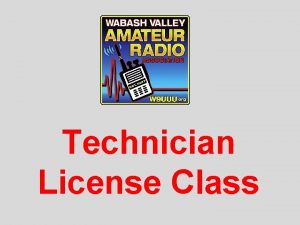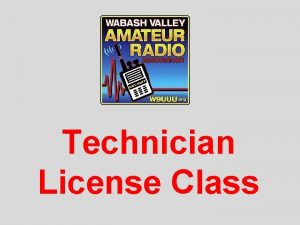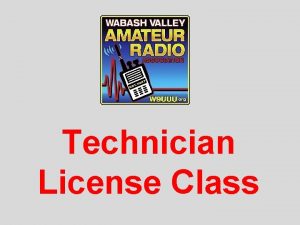Technician Licensing Class Talk to Outer Space Valid




























- Slides: 28

Technician Licensing Class Talk to Outer Space Valid July 1, 2018 Through June 30, 2022 1

Amateur Radio Technician Class Element 2 Course Presentation Ø ELEMENT 2 SUB-ELEMENTS (Groupings) • • • About Ham Radio Call Signs Control Mind the Rules Tech Frequencies Your First Radio Going On The Air! Repeaters Emergency! Weak Signal Propagation 2

Amateur Radio Technician Class Element 2 Course Presentation Ø ELEMENT 2 SUB-ELEMENTS (Groupings) Ø Talk to Outer Space! • Your Computer Goes Ham Digital! • Multi-Mode Radio Excitement • Run Some Interference Protection • Electrons – Go With the Flow! • It’s the Law, per Mr. Ohm! • Go Picture These! • Antennas • Feed Me With Some Good Coax! • Safety First! 3

Talk to Outer Space • The FCC Part 97 definition of a “space station’ is an amateur station located more than 50 km above the earth’s surface. T 1 A 07 4

Talk to Outer Space • Any amateur holding Technician Class license or higher, may make contact with an amateur station on the International Space Station using 2 meter and 70 cm band amateur radio frequencies. T 8 B 04 • The initials LEO tell you that the satellite is in a Low Earth Orbit. T 8 B 10 5

Talk to Outer Space • The following are provided by satellite tracking programs: ØMaps showing the real-time position of the satellite track over the earth; ØThe time, azimuth, and elevation of the start, maximum altitude, and the end of a pass; ØThe apparent frequency of the satellite transmission, including effects of Doppler shift. T 8 B 03 § All of these answers are correct. T 8 B 03 6

Talk to Outer Space • Keplerian elements are inputs to a satellite tracking program. T 8 B 06 Computer programs and websites can show you where and when an amateur satellite or the Space Station will be in range of your ham station. 7

Talk to Outer Space • A Satellite beacon is a transmission from a space station that contains information about a satellite. T 8 B 05 8

Talk to Outer Space • SSB, FM, CW/data are all common mode transmissions used by amateur radio satellites. • Rotation of the satellite and its antennas cause spin fading when referring to a satellite’s signals. 9 T 8 B 04 T 8 B 09

Talk to Outer Space • There are no restrictions on receiving telemetry from a space station. • The telemetry signal usually contains information on the health and status of the satellite. • Spin fading of satellite signals is caused by rotation of 10 the satellite and its antennas. T 8 B 11 T 8 B 09

Talk to Outer Space • With regard to satellite communications, an observed change in signal frequency caused by relative motion between the satellite and the earth station is called Doppler shift. T 8 B 07 Doppler Effect 11

Talk to Outer Space • Your signal strength on the downlink of the satellite should be about the same as the beacon. Other wise your uplink power is too high or to low. T 8 B 12 • Too much satellite uplink power can block access for other users. T 8 B 02 12

Talk to Outer Space • When a satellite is operating in mode U/V it means the satellite uplink is in the 70 cm band the downlink is in the 2 meter band. T 8 B 08 Frequency Bands High Frequency VHF UHF L band S band C band X band K band Frequency Range 21 - 30 MHz 144 - 146 MHz 435 - 438 MHz 1. 26 - 1. 27 GHz 2. 4 - 2. 45 GHz 5. 8 GHz 10. 4 GHz 24 Ghz Modes Mode H Mode V Mode U Mode L Mode S Mode C Mode X Mode K 13

Element 2 Technician Class Question Pool Talk to Outer Space Valid July 1, 2018 Through June 30, 2022 14

T 1 A 07 What is the FCC Part 97 definition of a space station? A. Any satellite orbiting the earth B. A manned satellite orbiting the earth C. An amateur station located more than 50 km above the Earth's surface D. An amateur station using amateur radio satellites for relay of signals 15

T 1 B 02 Which amateur radio stations may make contact with an amateur radio station on the International Space Station (ISS) using 2 meter and 70 cm band frequencies? A. Only members of amateur radio clubs at NASA facilities B. Any amateur holding a Technician or higherclass license C. Only the astronaut's family members who are hams D. Contacts with the ISS are not permitted on amateur radio frequencies 16

T 8 B 10 What do the initials LEO tell you about an amateur satellite? A. The satellite battery is in Low Energy Operation mode B. The satellite is performing a Lunar Ejection Orbit maneuver C. The satellite is in a Low Earth Orbit D. The satellite uses Light Emitting Optics 17

T 8 B 03 Which of the following are provided by satellite tracking programs? A. Maps showing the real-time position of the satellite track over the earth B. The time, azimuth, and elevation of the start, maximum altitude, and end of a pass C. The apparent frequency of the satellite transmission, including effects of Doppler shift D. All of these choices are correct 18

T 8 B 06 Which of the following are inputs to a satellite tracking program? A. B. C. D. The weight of the satellite The Keplerian elements The last observed time of zero Doppler Shift All of these answers are correct 19

T 8 B 05 What is a satellite beacon? A. The primary transmit antenna on the satellite B. An indicator light that shows where to point your antenna C. A reflective surface on the satellite D. A transmission from a space station that contains information about a satellite 20

T 8 B 04 What mode of transmission is commonly used by amateur radio satellites? A. B. C. D. SSB FM CW/data All of these choices are correct 21

T 8 B 11 Who may receive telemetry from a space station? A. Anyone who can receive the telemetry signal B. A licensed radio amateur with a transmitter equipped for interrogating the satellite C. A licensed radio amateur who has been certified by the protocol developer D. A licensed radio amateur who has registered for an access code from AMSAT 22

T 8 B 01 What telemetry information is typically transmitted by satellite beacons? A. B. C. D. The signal strength of received signals Time of day accurate to plus or minus 1/10 second Health and status of the satellite All of these choices are correct 23

T 8 B 09 What causes spin fading when referring to satellite signals? A. Circular polarized noise interference radiated from the sun B. Rotation of the satellite and its antennas C. Doppler shift of the received signal D. Interfering signals within the satellite uplink band 24

T 8 B 07 With regard to satellite communications, what is Doppler shift? A. A change in the satellite orbit B. A mode where the satellite receives signals on one band transmits on another C. An observed change in signal frequency caused by relative motion between the satellite and the earth station D. A special digital communications mode for some satellites 25

T 8 B 12 Which of the following is a good way to judge whether your uplink power is neither too low nor too high? A. Check your signal strength report in the telemetry data B. Listen for distortion on your downlink signal C. Your signal strength on the downlink should be about the same as the beacon D. All of these choices are correct 26

T 8 B 02 What is the impact of using too much effective radiated power on a satellite uplink? A. Possibility of commanding the satellite to an improper mode B. Blocking access by other users C. Overloading the satellite batteries D. Possibility of rebooting the satellite control computer 27

T 8 B 08 What is meant by the statement that a satellite is operating in mode U/V? A. The satellite uplink is in the 15 meter band the downlink is in the 10 meter band B. The satellite uplink is in the 70 cm band the downlink is in the 2 meter band C. The satellite operates using ultraviolet frequencies D. The satellite frequencies are usually variable 28
 Talk, read talk write template
Talk, read talk write template Amateurs talk tactics professionals talk logistics
Amateurs talk tactics professionals talk logistics Problem talk vs solution talk
Problem talk vs solution talk Technician class privileges
Technician class privileges The professor told him not to talk in class passive voice
The professor told him not to talk in class passive voice Unscented trajectory chapter 5
Unscented trajectory chapter 5 Space junk the space age began
Space junk the space age began Camera space to world space
Camera space to world space Cartesian space vs joint space
Cartesian space vs joint space Ndc to screen space
Ndc to screen space Wi ems licensing
Wi ems licensing Upgrade veritas backup exec 20 to 21
Upgrade veritas backup exec 20 to 21 Virginia dbhds human rights regulations
Virginia dbhds human rights regulations Process for licensing under fais
Process for licensing under fais Qualtrics penn state
Qualtrics penn state Qlikview licensing
Qlikview licensing Module 4 - open source software and licensing
Module 4 - open source software and licensing Microsoft 365a3
Microsoft 365a3 Mcoles licensing exam
Mcoles licensing exam Louisiana department of health health standards section
Louisiana department of health health standards section Sports licensing examples
Sports licensing examples 2005/lml/18/8
2005/lml/18/8 Industries requiring compulsory licensing *
Industries requiring compulsory licensing * During the initial licensing phase
During the initial licensing phase Utah daycare licensing
Utah daycare licensing Licensing franchising and other contractual strategies
Licensing franchising and other contractual strategies Umw book store
Umw book store Oregon piercing license
Oregon piercing license Mvls connexion
Mvls connexion



